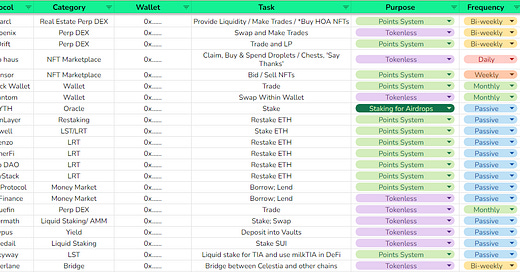2024 is shaping up to be the year of the airdrop. Points programs and pre-farming of airdrops have taken significant market share from yield farming as the preferred way to distribute new tokens:
Dozens of new airdrop points programs have launched this year.
Parcl, Kamino, and Tensor recently announced airdrops related to their points programs.
Stakers of TIA, ATOM, and other tokens have received numerous airdrops recently.
Blast accumulated over $2B in bridged TVL.
The points and airdrop meta is in full swing. Unfortunately, it can be overwhelming to keep track of them all. Add in multiple wallets and it’s easy to forget where you’re farming.
To make the most of airdrop season you need a system to strategically accumulate points and use tokenless protocols.
Here’s a framework to simplify and keep track of everything.
The first thing that I do to keep track of my airdrop farming is to break each farm down by several dimensions:
Chain/ecosystem - Solana, Sui, Avalanche, cross-chain, etc
Passive vs active farming - Passive farms are things like lending jitoSOL on MarginFi or staking TIA: you deposit once and are done. Active farms are things like making a transaction on zkSync Era or trading on Hyperliquid: farming requires regular, consistent action.
Frequency - For active farms, is this a task I want to take daily, weekly, bi-weekly, monthly, etc.
Using the active farms across multiple time periods is crucial. Arbitrum and Starknet, for example, looked for airdrop recipients to have made transactions in multiple distinct months. A good airdrop farming schedule takes the guesswork out of this, so that you can systematically use all protocols you’re farming.
The next thing I’d do would be to prioritize these airdrops. A few criteria I look for in airdrops are:
Ongoing points program (almost guaranteed airdrop)
Ease of farming (passive airdrops are easier)
Funding of the protocol (more funding = higher likely valuation)
Competitiveness (I prefer airdrops where I can be highly ranked)
Then, I’d schedule time each week to complete the active farming tasks and start executing. As far as how much money to use for each action, it depends on your personal situation, but the key is to simulate real usage and consider whether you’re being the sort of user that protocols would want to airdrop governance tokens to.
To keep track of this my team and I put this framework into an airdrop tracker. This tracker has over 50 potential airdrops populated already and can be easily expanded to include more.
The tracker takes the form of a Google Sheet, which I’m sharing with Dynamo DeFi premium subscribers. The big idea behind this is to systematize a process that’s usually random.
Keep reading with a 7-day free trial
Subscribe to Dynamo DeFi to keep reading this post and get 7 days of free access to the full post archives.




